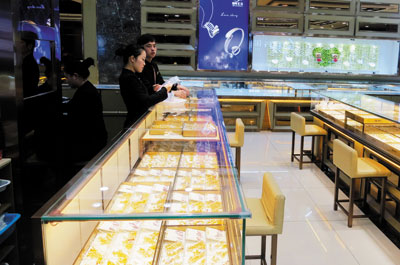
AS Chinese consumers cut back on gold purchases for a second year in a row, nowhere is the slowdown being felt more than in the country’s once-bustling jewelry manufacturing and retail hub of Shuibei.
Gold demand has taken a hit from a slowing economy and the Central Government’s anti-corruption drive, which has cut demand for luxury products, but there are fears of a more protracted loss of confidence among buyers in the world’s top consumer of the precious metal.
With buying in No.2 consumer India also soft, another year of weak Chinese demand would help pile more pressure on global gold prices languishing near six-year lows.
The hundreds of jewelry stores in Shuibei, an area in Luohu District of Shenzhen, have seen business take a downturn since a buying boom peaked in 2013 as Chinese consumers turn cautious.
“They don’t have confidence in gold now given the weak prices, so demand won’t pick up anytime soon,” said Wang Zhichang, regional manager of the Glory Gold store, adding revenue was likely to fall a further 10 percent next year on top of a drop of 10-20 percent this year.
Wang, who was among 30 staff in the store at a time when there were no customers, said that a number of jewelry factories had closed in the past year in the area.
Big retail chains, including Chow Tai Fook, thetop jeweler by market value, are also closing branches and cutting back store openings in Hong Kong and on the Chinese mainland.
Chow Tai Fook last month reported a 42 percent drop in net profit in the April-September period and said it would open only a net of 60 stores in China in its current financial year ending March, from a previous target of 150.
“Customers have become more rational with their purchases,” a company spokesperson said by email.
Illustrating the strains in the industry, Chinese banks have begun to see loan defaults by jewelry manufacturers, hurt by weak sales, Reuters reported last month.
From just 200 tons in 2003, Chinese demand for gold jewelry, bars and coins hit an all-time high of more than 1,000 tons in 2013, when prices of the metal snapped a 12-year rally.
Demand has since fallen back and with prices now down by more than a third since 2012 Chinese confidence has weakened in gold as an investment.
One of the biggest blows to China’s gold consumption has been the pullback of “dama” buying, a Chinese term for middle-aged women known for their love of hunting out a bargain.
They were at the forefront of the 2013 gold rush but many have had their fingers burnt as gold has repeatedly hit multi-year lows.
“The golden period of China’s dama demand has passed,” said Shu Jiang, chief analyst at Shandong Gold Group, the parent of Shandong Gold Mining Co. Ltd.
Shu said unless there was a drastic price drop over a short period of time, the dama were unlikely to return, though others argued that what is really required is a rebound in prices.
“Ironically, what you actually need to see for physical demand to pick up is for prices to rally,” said Victor Thianpiriya, commodity strategist at ANZ, who expects Chinese demand to decline next year.
“The confidence in gold as a supposed safe haven or as an investment has been battered over the last few years,” said Thianpiriya.
Indian demand has also taken a hit and in the December quarter is likely to fall to the lowest in eight years, hurt by poor investment demand and droughts that have slashed earnings for millions of farmers.
With the gold price outlook still bearish, some in the industry fear they might have to wait longer for a rebound.
“We’re expecting another 20 percent fall in business (next year),” said Zhang Fengming, the owner of another gold store in Shuibei.
“The Chinese will get back into gold when it becomes more of an attractive investment. I think in three to five years time there will be a rebound,” said Zhang, a 30-year veteran of the jewelry business.(SD-Agencies)
|

